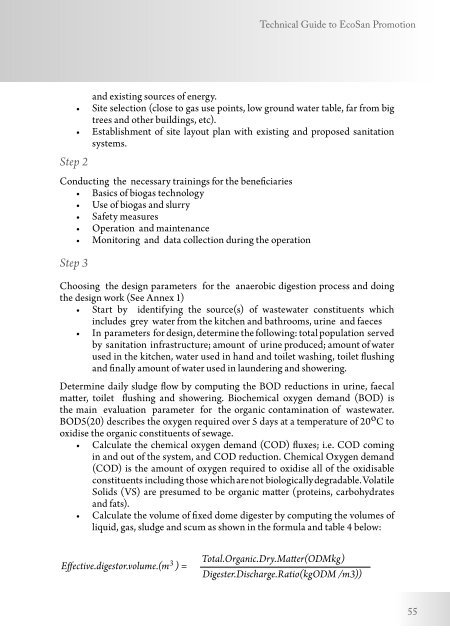Technical Guide to EcoSan Promotion
Technical Guide to EcoSan Promotion
Technical Guide to EcoSan Promotion
Create successful ePaper yourself
Turn your PDF publications into a flip-book with our unique Google optimized e-Paper software.
<strong>Technical</strong> <strong>Guide</strong> <strong>to</strong> <strong>EcoSan</strong> <strong>Promotion</strong><br />
and existing sources of energy.<br />
• Site selection (close <strong>to</strong> gas use points, low ground water table, far from big<br />
trees and other buildings, etc).<br />
• Establishment of site layout plan with existing and proposed sanitation<br />
systems.<br />
Step 2<br />
Conducting the necessary trainings for the beneficiaries<br />
• Basics of biogas technology<br />
• Use of biogas and slurry<br />
• Safety measures<br />
• Operation and maintenance<br />
• Moni<strong>to</strong>ring and data collection during the operation<br />
Step 3<br />
Choosing the design parameters for the anaerobic digestion process and doing<br />
the design work (See Annex 1)<br />
• Start by identifying the source(s) of wastewater constituents which<br />
includes grey water from the kitchen and bathrooms, urine and faeces<br />
• In parameters for design, determine the following: <strong>to</strong>tal population served<br />
by sanitation infrastructure; amount of urine produced; amount of water<br />
used in the kitchen, water used in hand and <strong>to</strong>ilet washing, <strong>to</strong>ilet flushing<br />
and finally amount of water used in laundering and showering.<br />
Determine daily sludge flow by computing the BOD reductions in urine, faecal<br />
matter, <strong>to</strong>ilet flushing and showering. Biochemical oxygen demand (BOD) is<br />
the main evaluation parameter for the organic contamination of wastewater.<br />
BOD5(20) describes the oxygen required over 5 days at a temperature of 20 o C <strong>to</strong><br />
oxidise the organic constituents of sewage.<br />
• Calculate the chemical oxygen demand (COD) fluxes; i.e. COD coming<br />
in and out of the system, and COD reduction. Chemical Oxygen demand<br />
(COD) is the amount of oxygen required <strong>to</strong> oxidise all of the oxidisable<br />
constituents including those which are not biologically degradable. Volatile<br />
Solids (VS) are presumed <strong>to</strong> be organic matter (proteins, carbohydrates<br />
and fats).<br />
• Calculate the volume of fixed dome digester by computing the volumes of<br />
liquid, gas, sludge and scum as shown in the formula and table 4 below:<br />
Effective.diges<strong>to</strong>r.volume.(m 3 ) =<br />
Total.Organic.Dry.Matter(ODMkg)<br />
Digester.Discharge.Ratio(kgODM /m3))<br />
55

















